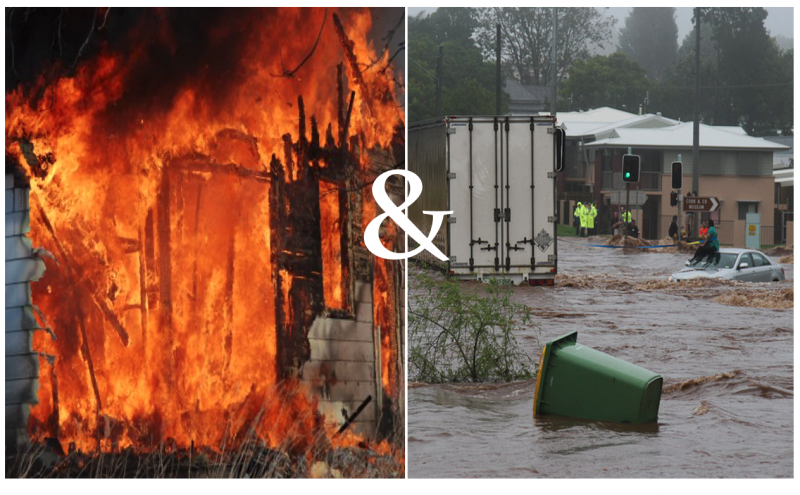Fires & Floods: Similarities and a Difference

The hundreds of raging wildfires this week along the Pacific Coast of the United States are a horrible tragedy, that is becoming only too familiar. During the recent Australian Summer they had their version. Nearly everyone realizes this is a result of increased warming, a key aspect of climate change. In some ways fire and flood seem opposite, but many are noting the connection to climate change, also known as global warming. It’s worth a moment to see the similarities between the surge in fires and floods and one key difference.
Our planet’s average temperature has warmed nearly two degrees Fahrenheit (about one degree Celsius) over the last century of the industrial era. (That was illustrated in my blog post last week in my graph of climate change.) Our hotter planet is a result of the heat-trapping greenhouse gases, particularly carbon dioxide. It has been calculated that we are adding the equivalent of five atomic bombs of heat energy to the planet every second of every hour, every day. (https://skepticalscience.com/earth-warming-5-atomic-bombs-per-sec.html) Ninety three percent of that excess heat is stored in the oceans. But even the other 7% causes significant effects on land.
In forests, warmer temperature mean the trees, shrubs and leaves are drier and easier to ignite. Hotter land temperatures and the melting of the polar ice caps, are causing new wind patterns such as the “polar vortex”, exceeding what we consider normal, even beyond the exceptional Santa Anna winds that frequently foster fires in California.
Like fires, flooding from extreme events including super storms and record rainfall are also associated with above normal evaporation due to warmer ocean temperatures. All of those disasters can occur suddenly, with high impact in limited areas, or broad regions, like the current wildfires.
Rising sea level is often lumped in as another flood manifestation, but it’s different. Of course the warming temperatures are also the cause of the melting glaciers and ice sheets, and thus, sea-level rise. Yet there is a difference between the threat from rising sea level and all those flood events and wildfires. Rising sea level does not pose a sudden risk like all those other events. Quite the contrary.
Because of the vastness of the oceans covering 72% of the globe, even the increased polar melting is only adding about a fifth of an inch (about five millimeters) a year to global sea level. By itself that is not even a noticeable component of flooding. The problem with the rising sea is the cumulative flooding caused by the unending melting ice and rising sea, which is now accelerating. On the current path of acceleration, the rising sea could well become many feet (meters) over the next hundred years. That changes the baseline. The “flood events” listed above pose a sudden threat with little warming or time to react. The same with fires. That danger and risk justifies immediate planning and efforts to reduce the risk, sometimes referred to as mitigation.
In contrast, even the worst case scenarios of 2-3 meters (8-10 feet) of sea-level rise this century seems so distant that it invite us to procrastinate, either hoping for some miracle solution, or simply leaving it for future generations to address. Rising sea level is like the drip filling the bucket. It does not evoke our “danger” signals, triggering flight or fight. Yet ironically, rising sea level is the only sure prediction we can make for the future. In a warmer world, there will be less ice on land. If even 10% of the ice on Greenland and Antarctica melt, sea level will be some six meters, or twenty feet above present. It does not have the immediacy of flood events or fires. Nonetheless, it demands that we plan ahead as it is now unstoppable. If we do not slow the warming resulting from the rise in atmospheric carbon dioxide, now at 414 ppm, it will happen sooner.
There are many threats ahead. Some demand that we tackle the problem of global warming now — and that we adapt to the threats, both the immediate and the long-term.
